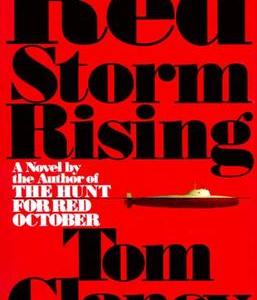In the 1980s, the Cold War still raged. It was projected to keep running well into the 90s and the 21st century. In fact, it almost went hot in 1983 from a combination of Soviet paranoia and Reagan’s obstinacy on the international stage. Able Archer almost saw the Soviets react to a NATO build up in Europe. That may have been a factor prompting Tom Clancy and Larry Bond to collaborate on one of the great technothrillers of the era.
Though Clancy’s name is plastered on the book, he assures us it was very much a collaborative work. That does tend to show in what ends up being concentrated on.
This is the story of Red Storm Rising.
Published in 1986, it was set twenty minutes into the future, and tried to describe a conventional war between the USSR and the East Bloc, and then the United States and NATO on the other side. It spends the first two hundred pages or so going to painstaking effort to try and set up a way for a conventional war between the two blocs to emerge, and while it can be taxing in a book ostensibly about what amounts to the Third World War, it is genuinely appreciated to get the feel of a political thriller.
Soviet politics means that they must contrive a reason for war, and they dedicate a highly detailed maskirovka to trying to politically split NATO. It partially works, but gets semi-foiled by an enormous stroke of luck for the Western forces. I’ll return to that in a bit.
War breaks out, and we end up with a situation looking like this:

After hostilities start we flit back and forth between a few view point characters. Some are integral to the overall story, others are not. The people we end up spending the most time with on the NATO side are the captain and crew of the frigate USS Pharis, the submarine USS Chicago, Robert Toland, an intelligence analyst and Michael Edwards, an Air Force meteorologist on Iceland. There’s some other characters mixed in (the driver of an M1 Abrams, fighter pilots and drivers of the fictional F-19 Frisbee) but these four are the ones we spend the most time with.
On the Soviet side we have Pavel Alekseyev a commander of armored forces, energy minister Mikhail Sergetov and his son Ivan who serves on Alekseyev’s staff. Then there’s various named and unnamed Soviet commanders and troops who play some part in the story.
The British, Americans and Soviets are all well represented, but the other members of the Warsaw Pact or NATO only really show up in passing or in scenes where they’re necessary for some plot point or another. The main drivers of the story are the ones mentioned above and they provide access to the campaign both above and below the Atlantic Ocean, in the air, and on land.
Like many items in the technothriller genre, it throws a lot of technical data at you. If you’re familiar with the genre or some of the period weapons systems (or looking to learn some) it’s a decent speculation on what a war might look like. On the seas it plays out much like the Battle of the Atlantic in both world wars as Operation REFORGER is undertaken to get American troops and supplies to Europe to hold the line.
You can tell that Clancy and Bond played to their strengths in this story. There’s a vast amount of space in the novel is dedicated to describing submarine warfare and anti-submarine warfare by the NATO navies, and then the air war over the seas and land in Europe. Larry Bond had previously worked designing wargames based around naval war and Clancy’s best work was The Hunt for Red October so you can’t blame them for doing what they know well. It does give the war a much needed expansion of scope from the seas to the skies which might be otherwise overlooked.
That being said, the story really overlooked the war in Europe, which one would expect to be the main event. Instead, we spend a lot of time dealing with the campaign around Iceland which, while interesting at times, sucked up a lot of pages which might have been better spent with characters caught up in the fighting around Germany. I didn’t mind the diversions in Iceland, but they ate up a lot of time and I never felt that the ground war in Europe got the attention it might have deserved.
I won’t critique the war itself, that’s for people with a much better understanding of tactics and strategy than myself. However, I will note that for NATO to do as well as it did, especially on the ground, ended up relying on a massive number of lucky breaks and coincidences. From catching a Spetznaz operative in very contrived circumstances to a deception plan going better than can really be imagined in the late ground war, and Soviet troops held back, things had to break just right for this to work. I felt that the authors were really having to avoid straight up admitting that the Soviets would probably have ground the NATO troops into the dust, and perhaps this was why the ground war was an afterthought as they remained in places where NATO had a definite edge or there was more competition. Without a lot of effort being expended looking at the fighting in Europe, I can’t say.
The cast too is not particularly deep. They serve their purpose, having enough personal moments to make them human and not one dimensional, but never really feeling like those with lives and dreams outside the war. None were very well rounded, and the Soviets just barely manage to not come off as simple card carrying villains. Unlike Ralph Peters, The War in 2020 we don’t get a lot of insight into the Western political minds vs those of the Soviets.
I would almost describe this book as if The Anglo-American Nazi War were a true novel. Just as much jargon, but more characters to keep you reading and intrigued at events as they play out.
Overall, this is an interesting novel which tries to posit why the war happens and nukes don’t fly. It does a good job portraying all the technology at the time (everything that wasn’t classified and the known Soviet capabilities) within the limits of knowledge. Though the plot is not particularly exciting since I was able to more or less guess much of what would happen, it did keep me turning the pages to see how things would play out.
Lacking a bit of the oomph one would expect in a war novel, and more than a few wasted pages, it nevertheless manages to present a vision of the terrors of modern conventional war and the clash of arms that could have been if the war had gone hot in the 1980s.


2 thoughts on “Red Storm Rising”